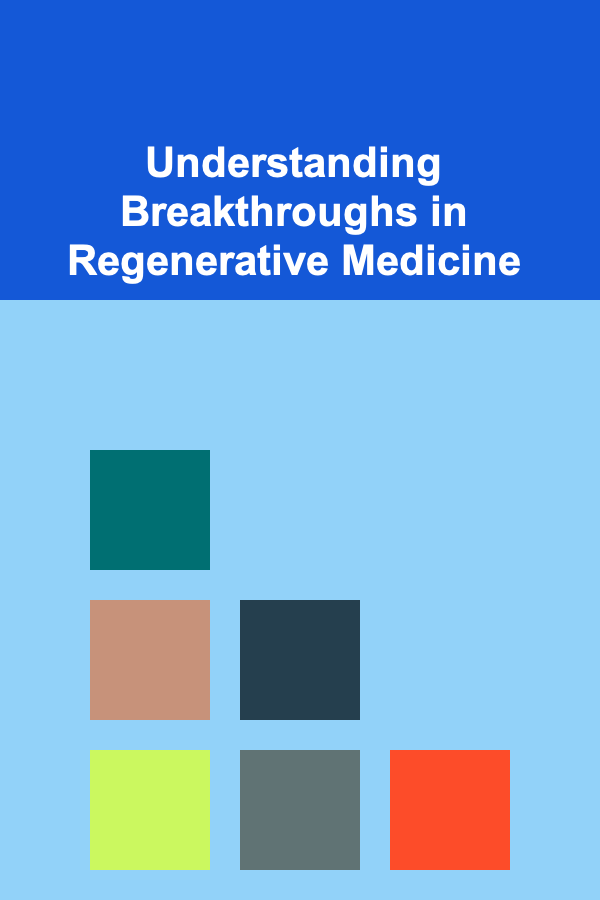
Understanding Breakthroughs in Regenerative Medicine
ebook include PDF & Audio bundle (Micro Guide)
$12.99$8.99
Limited Time Offer! Order within the next:

Regenerative medicine, a field focused on repairing or replacing damaged tissues and organs, holds immense promise for treating a wide range of diseases and injuries. Its breakthroughs are rapidly transforming the landscape of healthcare, offering hope for conditions previously considered incurable. However, navigating this complex field and understanding its advances requires a nuanced perspective. This article delves into the key concepts, approaches, and challenges involved in regenerative medicine, aiming to provide a comprehensive understanding of its current state and future potential.
What is Regenerative Medicine?
At its core, regenerative medicine aims to restore function to tissues and organs damaged by disease, injury, or aging. Unlike traditional medicine, which often focuses on managing symptoms or slowing disease progression, regenerative medicine seeks to address the root cause by actively repairing or replacing damaged components. This can involve a variety of strategies, including:
- Cellular Therapies: Using cells, either from the patient (autologous) or a donor (allogeneic), to replace or repair damaged tissues. This includes stem cell therapies, immune cell therapies, and other cell-based approaches.
- Tissue Engineering: Combining cells, scaffolds (support structures), and growth factors to create functional tissues in the laboratory, which can then be implanted into the patient.
- Biomaterials and Devices: Developing materials and devices that can stimulate the body's own regenerative capacity. These materials can provide structural support, deliver growth factors, or modulate the immune response to promote tissue repair.
- Gene Therapy: Modifying genes to correct genetic defects that contribute to disease or to enhance the body's ability to regenerate tissues.
- Small Molecule Therapies: Identifying and developing small molecules that can stimulate endogenous regeneration pathways. This approach aims to harness the body's own healing mechanisms to repair damaged tissues.
The underlying principle is to leverage the body's innate capacity for self-healing, augmented by external interventions to promote tissue regeneration and functional restoration.
Key Areas of Breakthroughs
Regenerative medicine is advancing rapidly across several key areas, each with its own unique challenges and opportunities:
1. Stem Cell Therapies
Stem cells, with their unique ability to differentiate into various cell types, are a cornerstone of regenerative medicine. Breakthroughs in this area include:
- Induced Pluripotent Stem Cells (iPSCs): The discovery of iPSCs, cells that can be reprogrammed from adult cells back into a pluripotent state, has revolutionized the field. iPSCs offer a virtually unlimited source of patient-specific cells for regenerative therapies, avoiding ethical concerns associated with embryonic stem cells. Significant progress has been made in differentiating iPSCs into specific cell types for treating various diseases, including macular degeneration, spinal cord injury, and heart failure.
- Mesenchymal Stem Cells (MSCs): MSCs, found in bone marrow, adipose tissue, and other tissues, have shown promise in treating a range of inflammatory and autoimmune diseases. Their therapeutic effects are thought to be mediated through paracrine signaling, where they release factors that modulate the immune response and promote tissue repair. Clinical trials are exploring the use of MSCs for treating conditions such as osteoarthritis, multiple sclerosis, and graft-versus-host disease.
- Hematopoietic Stem Cell Transplantation (HSCT): While not a new therapy, HSCT, used to treat blood cancers and other hematologic disorders, represents a successful example of stem cell therapy. Advances in HSCT, including improved matching techniques and reduced toxicity, continue to improve patient outcomes.
However, challenges remain in controlling stem cell differentiation, ensuring their long-term survival and integration into host tissues, and preventing unwanted side effects such as tumor formation.
2. Tissue Engineering
Tissue engineering aims to create functional tissues and organs in the laboratory for implantation into patients. Key breakthroughs include:
- 3D Bioprinting: 3D bioprinting allows for the precise deposition of cells, biomaterials, and growth factors to create complex three-dimensional structures. This technology holds immense potential for creating personalized tissues and organs for transplantation. Progress has been made in bioprinting skin, cartilage, and even small portions of organs like the liver and kidney.
- Decellularization and Recellularization: This technique involves removing all cells from a donor organ, leaving behind a scaffold of extracellular matrix (ECM). The ECM scaffold can then be recellularized with the patient's own cells, creating a personalized organ for transplantation. Decellularized lungs, hearts, and livers have been successfully created in the laboratory and tested in animal models.
- Development of Advanced Biomaterials: The development of biocompatible and biodegradable biomaterials is crucial for tissue engineering. Researchers are creating materials that can mimic the natural ECM, provide structural support for cells, and release growth factors to promote tissue regeneration.
Challenges in tissue engineering include creating vascularized tissues that can receive adequate blood supply, scaling up production for clinical applications, and ensuring long-term functionality of engineered tissues.
3. Gene Therapy in Regenerative Medicine
Gene therapy is increasingly being used to enhance regenerative processes. Breakthroughs include:
- Gene Editing Technologies (CRISPR-Cas9): CRISPR-Cas9 allows for precise editing of genes, offering the potential to correct genetic defects that contribute to disease or to enhance the expression of genes that promote tissue regeneration. This technology is being explored for treating genetic disorders such as Duchenne muscular dystrophy and cystic fibrosis, as well as for enhancing the regenerative capacity of cells used in cell therapies.
- Viral Vectors for Gene Delivery: Adeno-associated viruses (AAVs) are commonly used to deliver therapeutic genes into cells. Advances in AAV vector design have improved their safety and efficacy, making them a promising tool for gene therapy.
- Enhancing Growth Factor Expression: Gene therapy can be used to increase the expression of growth factors, such as bone morphogenetic proteins (BMPs) and vascular endothelial growth factor (VEGF), which promote tissue regeneration and angiogenesis (formation of new blood vessels).
Challenges in gene therapy include ensuring the safe and efficient delivery of genes to target cells, minimizing off-target effects, and achieving long-term gene expression.
4. Biomaterials and Devices for Regeneration
Biomaterials and devices are playing an increasingly important role in regenerative medicine by providing structural support, delivering growth factors, and modulating the immune response. Breakthroughs include:
- Scaffolds for Tissue Regeneration: Biomaterial scaffolds can provide a framework for cells to attach, proliferate, and differentiate, promoting tissue regeneration. These scaffolds can be made from a variety of materials, including collagen, hyaluronic acid, and synthetic polymers.
- Drug-Eluting Implants: Implants that release growth factors or other therapeutic agents can stimulate tissue regeneration at the site of injury. These implants can be used to promote bone healing, cartilage regeneration, and wound healing.
- Bioactive Materials: Materials that can interact with cells and tissues to promote regeneration are being developed. For example, some materials can stimulate the formation of new blood vessels or modulate the immune response to promote tissue repair.
Challenges in this area include designing materials that are biocompatible, biodegradable, and mechanically strong, as well as ensuring their long-term efficacy and safety.
5. Immunomodulation in Regenerative Medicine
The immune system plays a crucial role in both promoting and inhibiting tissue regeneration. Breakthroughs in immunomodulation are essential for successful regenerative therapies:
- Controlling Inflammation: Chronic inflammation can inhibit tissue regeneration. Strategies to control inflammation, such as the use of anti-inflammatory drugs or the delivery of immunosuppressive factors, can promote tissue repair.
- Modulating the Immune Response to Allografts: Preventing rejection of allografts (tissues or organs from a donor) is a major challenge in regenerative medicine. Immunosuppressive drugs are commonly used to prevent rejection, but these drugs can have significant side effects. Researchers are developing new strategies to modulate the immune response to allografts, such as the use of regulatory T cells (Tregs) or the development of more targeted immunosuppressive therapies.
- Stimulating Macrophage Polarization: Macrophages, a type of immune cell, can play both pro-inflammatory and pro-regenerative roles. Strategies to stimulate the polarization of macrophages towards a pro-regenerative phenotype can promote tissue repair.
Understanding the complex interplay between the immune system and tissue regeneration is crucial for developing effective regenerative therapies.
Challenges and Future Directions
While regenerative medicine holds immense promise, significant challenges remain before its widespread clinical application:
1. Regulatory Hurdles
The regulatory landscape for regenerative medicine products is complex and evolving. Clear and consistent regulations are needed to ensure the safety and efficacy of these therapies while also promoting innovation. Navigating the regulatory pathway for cell therapies, tissue-engineered products, and gene therapies can be challenging and time-consuming.
2. Scalability and Manufacturing
Scaling up production of regenerative medicine products is a major challenge. Many regenerative therapies are currently produced on a small scale in academic laboratories. Developing efficient and cost-effective manufacturing processes is crucial for making these therapies available to a wider patient population. Automated manufacturing systems and standardized protocols are needed to ensure the quality and consistency of regenerative medicine products.
3. Cost and Accessibility
Regenerative medicine therapies are often expensive, limiting their accessibility to many patients. Reducing the cost of these therapies is essential for ensuring equitable access. Strategies to reduce costs include developing more efficient manufacturing processes, using less expensive materials, and streamlining the regulatory pathway.
4. Long-Term Efficacy and Safety
Long-term efficacy and safety data are needed for many regenerative medicine therapies. Clinical trials are needed to evaluate the long-term benefits and risks of these therapies. Post-market surveillance is also important for monitoring the safety and efficacy of regenerative medicine products after they are approved for clinical use.
5. Addressing Ethical Considerations
Regenerative medicine raises several ethical considerations, including the sourcing of stem cells, the potential for off-label use, and the equitable distribution of these therapies. Open and transparent discussions about these ethical issues are needed to ensure that regenerative medicine is developed and used responsibly.
Despite these challenges, the future of regenerative medicine is bright. Continued research and development in this field are expected to lead to breakthroughs in the treatment of a wide range of diseases and injuries. Future directions include:
- Personalized Regenerative Medicine: Tailoring regenerative therapies to the individual patient based on their genetic makeup, disease status, and other factors.
- Combination Therapies: Combining different regenerative medicine approaches, such as cell therapies, gene therapies, and biomaterials, to achieve synergistic effects.
- Regenerative Medicine for Aging: Developing therapies to slow down or reverse the aging process by repairing age-related tissue damage.
- Artificial Organs: Developing fully functional artificial organs for transplantation, eliminating the need for donor organs.
- Enhanced Tissue Regeneration: Identifying and developing new strategies to enhance the body's own regenerative capacity.
Conclusion
Regenerative medicine is a rapidly evolving field with the potential to revolutionize healthcare. Understanding the key concepts, approaches, and challenges involved in this field is essential for appreciating its current state and future potential. While significant challenges remain, continued research and development are expected to lead to breakthroughs in the treatment of a wide range of diseases and injuries, offering hope for conditions previously considered incurable. By addressing the regulatory hurdles, scalability issues, cost concerns, and ethical considerations, we can pave the way for the widespread clinical application of regenerative medicine and unlock its transformative potential for improving human health.
Staying informed about the latest advancements in regenerative medicine requires critical thinking and a balanced perspective. Evaluating the evidence behind new therapies, understanding the limitations of current approaches, and engaging in informed discussions about the ethical implications are crucial for navigating this exciting and rapidly evolving field.
Reading More From Our Other Websites
- [Personal Investment 101] How to Recognize Investment Scams and Frauds
- [Home Family Activity 101] How to Make Your Family Karaoke Night More Engaging with Themed Dress-Up and Homemade Props
- [Weaving Tip 101] From Loom to Trail: Crafting a Journey Through Creative Weaving
- [Organization Tip 101] How to Share Your Hobby Collection Online While Staying Organized
- [Home Holiday Decoration 101] How to Incorporate Handmade Decorations for a Personalized Holiday Look
- [Home Cleaning 101] How to Keep Your Home Clean with Kids and Pets
- [Home Cleaning 101] How to Keep Your Home Clean With Minimal Effort
- [Toy Making Tip 101] Toy Making as Therapy: Creative Ways to Mark a New Beginning
- [Home Budget Decorating 101] How to Create a Stylish Bedroom with Budget-Friendly Pieces
- [Soap Making Tip 101] Essential Oils for Irresistible Homemade Soap Scents

How to Build an Income-Generating Deep Learning Portfolio
Read More
How to Clean Your Bathroom Without Harsh Chemicals
Read More
How to Make Money Online as an Email Marketing Manager: 10 Actionable Ideas
Read More
How to Reduce Grocery Costs Without Sacrificing Quality
Read More
Using Data Analytics to Boost Profit
Read More
How to Write a Winning Consulting Proposal
Read MoreOther Products

How to Build an Income-Generating Deep Learning Portfolio
Read More
How to Clean Your Bathroom Without Harsh Chemicals
Read More
How to Make Money Online as an Email Marketing Manager: 10 Actionable Ideas
Read More
How to Reduce Grocery Costs Without Sacrificing Quality
Read More
Using Data Analytics to Boost Profit
Read More